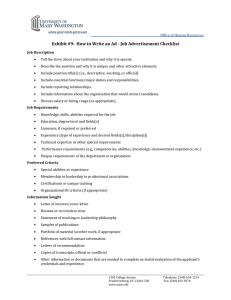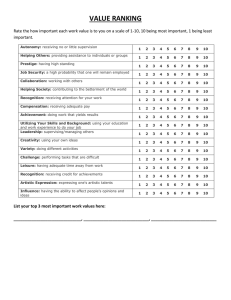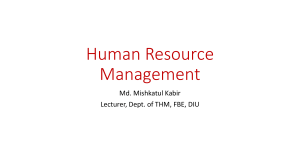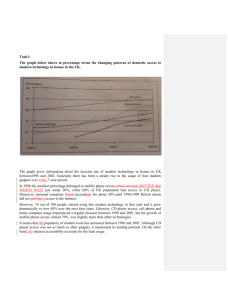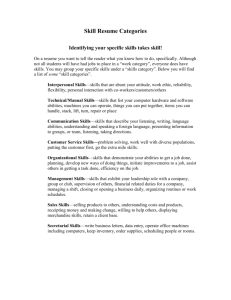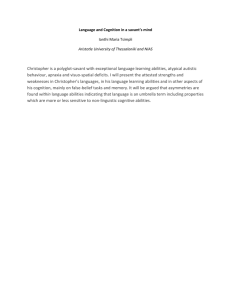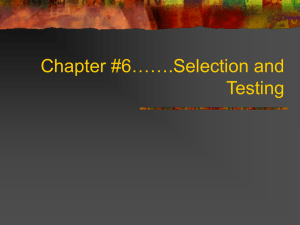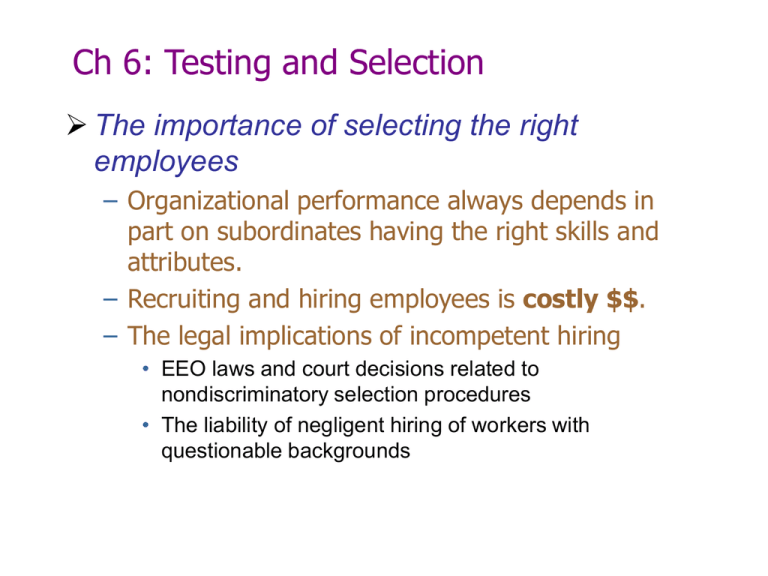
Ch 6: Testing and Selection
The importance of selecting the right
employees
– Organizational performance always depends in
part on subordinates having the right skills and
attributes.
– Recruiting and hiring employees is costly $$.
– The legal implications of incompetent hiring
• EEO laws and court decisions related to
nondiscriminatory selection procedures
• The liability of negligent hiring of workers with
questionable backgrounds
Basic Testing Concepts
Reliability
– The consistency of scores obtained by the same
person when retested with the identical or
equivalent tests.
– Are the test results stable over time?
Test validity
– The accuracy with which a test, interview, and so
on measures what it purports to measure or fulfills
the function it was designed to fill.
– Does the test actually measure what we need for
it to measure?
Types of Validity
Criterion validity
– A type of validity based on showing that scores on
the test (predictors) are related to job
performance (criterion).
• Are test scores in this class related to students’
knowledge of human resource management?
Content validity
– A test that is content valid is one that contains a
fair sample of the tasks and skills actually needed
for the job in question.
• Do the test questions in this course relate to human
resource management topics?
• Is taking an HR course the same as doing HR?
Testing Program Guidelines
1. Use tests as supplements.
2. Validate the tests.
3. Monitor your testing/selection program
4. Keep accurate records.
5. Use a certified psychologist.
6. Manage test conditions.
7. Revalidate periodically.
Using Tests at Work
Major types of tests used by employers
– Basic skills tests (45%)
– Drug tests (47%)
– Psychological tests (33%)
Use of testing
– Less overall testing now but more testing is used
as specific job skills and work demands increase.
• Screen out bad or dishonest employees
• Reduce turnover by personality profiling
Source of tests
– Test publishers
Computer-Interactive Testing
Types of tests
–
–
–
–
Specialized work sample tests
Numerical ability tests
Reading comprehension tests
Clerical comparing and checking tests
Online tests
–
–
–
–
Telephone prescreening
Offline computer tests
Virtual “inbox” tests
Online problem solving tests
Types of Tests
Tests of cognitive abilities
– Intelligence Tests
• Tests of general intellectual abilities that measure a
range of abilities, including memory, vocabulary, verbal
fluency, and numerical ability.
– Aptitude tests
• Tests that measure specific mental abilities, such as
inductive and deductive reasoning, verbal
comprehension, memory, and numerical ability.
Types of Tests (cont’d)
Tests of motor abilities
– Tests that measure motor abilities, such as finger
dexterity, manual dexterity, and reaction time.
Tests of physical abilities
– Tests that measure static strength, dynamic
strength, body coordination, and stamina.
Problem from the Test of
Mechanical Comprehension
Which gear will turn the same way as the driver?
Source: Reproduced by permission. Copyright 1967, 1969 by The Psychological Corporation, New York, NY. All rights
reserved. Author’s note: 1969 is the latest copyright on this test, which is still the main one used for this purpose.
Figure 6–5
Measuring Personality and Interests
Personality tests
– Tests that use projective techniques and trait
inventories to measure basic aspects of an
applicant’s personality, such as introversion,
stability, and motivation.
– Disadvantage
• Personality tests—particularly the projective type—are
the most difficult tests to evaluate and use.
– Advantage
• Tests have been used successfully to predict
dysfunctional job behaviors and identify successful
candidates for overseas assignments.
The “Big Five”
Extraversion
– The tendency to be sociable, assertive, active, and to experience
positive effects, such as energy and zeal.
Emotional stability/neuroticism
– The tendency to exhibit poor emotional adjustment and experience
negative effects, such as anxiety, insecurity, and hostility.
Openness to experience
– The disposition to be imaginative, nonconforming, unconventional,
and autonomous.
Agreeableness
– The tendency to be trusting, compliant, caring, and gentle.
Conscientiousness
– Is comprised of two related facets: achievement and dependability.
Other Tests (cont’d)
Web-Based (Online) testing
– Eliminates costly and inefficient paper-and-pencil
testing processes.
– Allows for role-playing by applicants.
– Use of computer-based scoring eliminates rater
bias.
– Provides immediate scoring and feedback of
results to applicants.
– Can be readily customized for specific jobs.
Work Samples
Work samples
– Actual job tasks are used in testing applicants’
performance.
Work sampling technique
– A testing method based on measuring an
applicant’s performance on actual basic job tasks.
Work Simulations
Management assessment center
– A simulation in which management candidates are
asked to perform realistic tasks in hypothetical
situations and are scored on their performance.
Typical simulated exercises include:
–
–
–
–
–
–
The in-basket
Leaderless group discussion
Management games
Individual presentations
Objective tests
The interview
Work Simulations (cont’d)
Video-Based situational testing
– A situational test comprised of several video
scenarios, each followed by a multiple choice
question that requires the candidate to choose
from among several courses of action.
– While the evidence is mixed, the results suggest
that video-based situational tests can be useful for
selecting employees.
Work Simulations (cont’d)
The miniature job training and evaluation
approach
– Candidates are trained to perform a sample of the
job’s tasks, and then are evaluated on their
performance.
– The approach assumes that a person who
demonstrates that he or she can learn and
perform the sample of tasks will be able to learn
and perform the job itself.
Honesty Tests (i.e., Integrity Tests)
Paper-and-pencil honesty tests
– Psychological tests designed to predict job
applicants’ proneness to dishonesty and other
forms of counterproductivity.
– Measure attitudes regarding things like tolerance
of others who steal, acceptance of rationalizations
for theft, and admission of theft-related activities.

